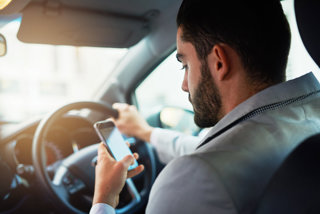Fleet and safety manufacturers could drive demand for 'drive-safe' modes on smartphones, says the RAC Foundation.
Around two-thirds (66%) of the UK population are estimated to own a smartphone, with most of them familiar with flight-safe modes which restricts communications that could potentially interfere with a plane’s systems.
Yet many drivers risk being distracted by a range of applications on their phones which are accessible whether they are at the wheel or not.
Each year at least 70 fatal accidents on Britain’s roads have ‘distraction in vehicle’ as a contributory factor. ‘Driver using mobile phone’ is a factor in some 20 fatal accidents a year.
The RAC Foundation asked TRL to carry out surveys and interviews with a range of people who have an interest in this subject - including representatives from vehicle manufacturers, telecoms providers and phone manufacturers – to gauge what industry is doing to limit the use of potentially distracting technology in the car.
In general terms, while a great deal of thought goes into the design of built-in equipment and dashboard layout, when it comes to products not specifically designed for in-car use:
- ‘Distraction in vehicle’ was not consistently considered to be a priority during the design phase
- It was largely thought to be up to the driver to make sure their use of technology in the car complied with the law
- Without a legal obligation on them few companies would incorporate limitations on the use of their equipment as they would be at a commercial disadvantage
- Demands for technologies such as drive-safe mode could come from fleet and safety managers who are more directly aware of the legal and moral duty to protect their employees and the public
At the moment there do not appear to be any internationally accepted guidelines and standards specifically related to the design of mobile phones and communications devices for use while driving.
There is a range of apps which drivers can voluntarily download onto their phones to help limit their functionality and hence reduce distraction.
Do-not-disturb functions are also available on handsets themselves, although are not specifically related to driving.
Steve Gooding, director of the RAC Foundation, said: “In many ways smartphone technology and mobile communications are a Godsend for road users, allowing us to do everything from getting directions to dodging congestion to calling for help if we break down.
“Yet the more functionality our cars and electronic devices have, the greater the chance that drivers get distracted or overwhelmed with information, particularly when using smartphones as sat-navs while all the other functions are still ‘live’.
“A key question is where responsibility lies. Many in the industry say the onus must be on the user rather than the manufacturer.
“There may come a day when autonomous cars allow us to spend all our time looking at our mobile, tablet and computer screens.
"Until then as drivers we need to make sure we have our eyes on the road.”
















Login to comment
Comments
No comments have been made yet.